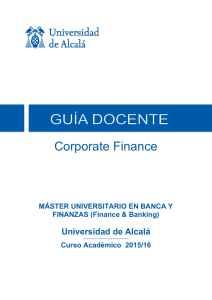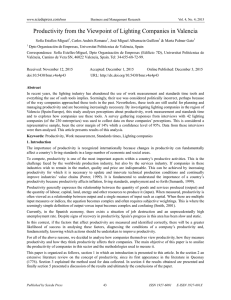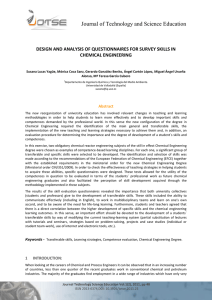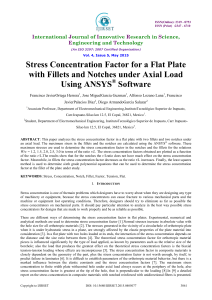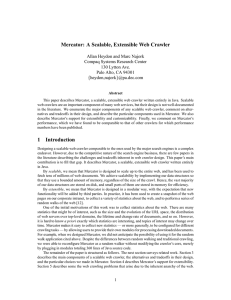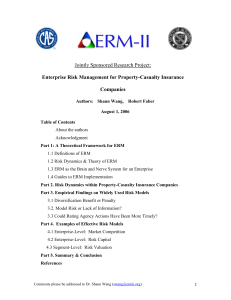fundamental concepts to perform a business`s financial planning in
Anuncio
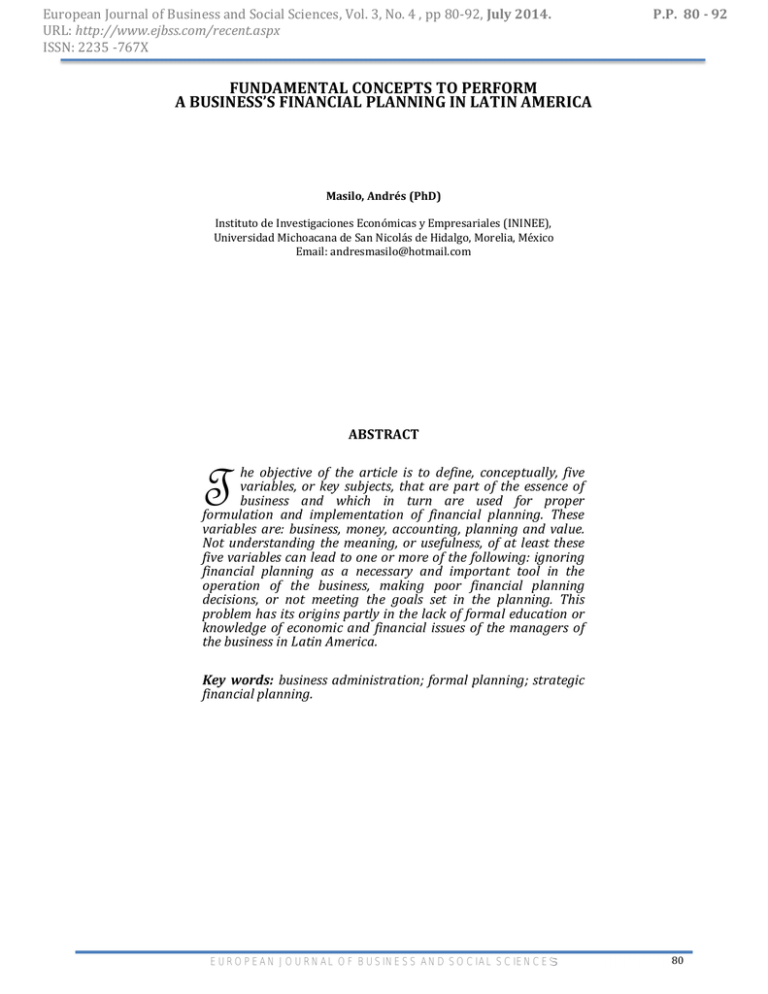
European Journal of Business and Social Sciences, Vol. 3, No. 4 , pp 80-92, July 2014. URL: http://www.ejbss.com/recent.aspx ISSN: 2235 -767X P.P. 80 - 92 FUNDAMENTAL CONCEPTS TO PERFORM A BUSINESS’S FINANCIAL PLANNING IN LATIN AMERICA Masilo, Andrés (PhD) Instituto de Investigaciones Económicas y Empresariales (ININEE), Universidad Michoacana de San Nicolás de Hidalgo, Morelia, México Email: [email protected] ABSTRACT he objective of the article is to define, conceptually, five variables, or key subjects, that are part of the essence of business and which in turn are used for proper formulation and implementation of financial planning. These variables are: business, money, accounting, planning and value. Not understanding the meaning, or usefulness, of at least these five variables can lead to one or more of the following: ignoring financial planning as a necessary and important tool in the operation of the business, making poor financial planning decisions, or not meeting the goals set in the planning. This problem has its origins partly in the lack of formal education or knowledge of economic and financial issues of the managers of the business in Latin America. T Key words: business administration; formal planning; strategic financial planning. EUROPEAN JOURNAL OF BUSINESS AND SOCIAL SCIENCES 80 European Journal of Business and Social Sciences, Vol. 3, No. 4 , pp 80-92, July 2014. URL: http://www.ejbss.com/recent.aspx ISSN: 2235 -767X P.P. 80 - 92 1. Introduction Financial planning is understood as the most important tool for companies to make financial decisions and achieve financial goals. Without proper financial planning, it would be difficult to achieve, for example, a loan from a financial institution, the growth of a new company or an increase of cash flows from a business with years of operation. Mazzarol (2005) shows an analysis of different studies focused on the formal planning of small firms and mentions that, although it is not possible to determine the benefit of formal planning in small firms, it is an important tool for large companies and firms with the objective of growth. On the other hand, he states that it is a necessary tool for businesses seeking government support or any kind of loan. Gansel (2005) talks about a positive correlation between planning and the success of a business and cites several studies showing that financial planning is one of the most important tools for the administration of a business. For Ortega (2008), financial strategy should be present in the decision making process of executives whose task is to manage a business and mentions that it is essential that persons engaged in business know how to perform sound financial planning. In relation to formal planning in companies of different sizes, Mazzarol (2005) explains that there is a relationship between company size and the level of formal planning. He says that the larger the company the greater the likelihood that companies will undertake formal planning because larger companies employ highly educated professionals with the skills necessary to perform formal planning. He also mentions the work of Unni (1984) which states that most small firms do not have any formal business planning. Financial planning can be defined as that which describes the economic activities performed by a company and the resources it needs to achieve its objectives. This usually includes an economic and financial analysis of the market and industry, an extensive and thorough analysis of the financial state of the company and an estimate and analysis of the statements of financial information, including its cash flows. Here, Ortega (2008) mentions that financial planning is a technique that meets a set of procedures, instruments and objectives in order to establish the economic and financial forecasts and goals of an enterprise, considering the resources that the enterprise has and the ones that it requires to achieve its objectives. Regarding the use of financial planning in companies in developing countries, the question here is whether the process of financial planning in Latin American countries is even more necessary than in developed ones. First, we should note that the World Bank ranks the majority of Latin American countries in the category of developing countries, including the bigger and more populous ones like Argentina, Brazil, Colombia and Mexico. Pereiro (2002) performed an analysis of these countries, and other emerging markets, and described these as less efficient and segmented than developed countries. That is, these are countries with more concentrated, volatile, and regulated markets; with few operations and greater price volatility, scarce and unreliable information, and high transaction costs. On the other hand, he mentions the work of Erb, Harvey & Viskanta (1995), which shows that these countries have country risk ratings, on average, higher than developed countries. Therefore, they are more risky and volatile in terms of political and economic issues. With scenarios of greater uncertainty, the process of financial planning in emerging countries, as a tool for decision making, becomes even more important than in developed countries. In addition to the difficulties of getting loans, or other resources, and meeting growth objectives, the lack of formal planning, or poor planning, contributes to at least two major problematic situations, which in turn impact on the overall economy of Latin American countries. The first, with a direct influence, refers to the largest percentage of failures, or loss of money in unproductive investments, of startups in Latin American countries compared to developed countries. The second, with an indirect effect, refers to the lower contribution of small enterprises in the domestic production of these countries. Zevallos (2003) estimates, EUROPEAN JOURNAL OF BUSINESS AND SOCIAL SCIENCES 81 European Journal of Business and Social Sciences, Vol. 3, No. 4 , pp 80-92, July 2014. URL: http://www.ejbss.com/recent.aspx ISSN: 2235 -767X P.P. 80 - 92 based on studies, that in developing countries between 50% and 75% of new businesses fail or cease to exist during the first three years of operation. In Mexico, according to the Treasury1, about 65% of all new firms fail within the first two years of operation. In the United States2 , according to the Committee of Labor Statistics3, the failure rate is about 48% in the fourth year of operation. Regarding the contribution of small businesses in the Gross Domestic Product (GDP), Baralla & Arazi (2012) estimate that, on average, in Latin America the contribution is 40%. Morales (2011) mentions that in Mexico it is 41%, compared to 55% in the European Union and 51% in the United States. Therefore, what is the main reason why companies do not perform formal planning? Several studies point out, as the main cause, the lack of basic education in topics related to business; including administrative, accounting, financial and economic aspects. We can also point out the lack of training in business as one of the causes of poor planning leading to the failure of new businesses. Posner (1985), based on studies of formal planning in small businesses, highlights as one of the main causes the lack of technical skills of managers in business planning. Scase & Goffee (1980), on the same subject, highlight the lack of skills but in strategic planning. Hull (2008), discussing the estimation of rates, explains that most companies are in the business of manufacturing or services, so they don’t have the skills or abilities to predict financial variables such as exchange and interest rates or commodity price fluctuations. Velázquez (2008), citing a study of the Fundación para el Desarrollo Sostenible de México (FOUNDES), highlights administrative mistakes due to the poor administrative capacity of employers as the main factor of failures of companies in Mexico. He estimates that 43% of businesses fail because of administrative errors and explains that only two out of ten employers are formally trained to manage their own business. Bolaños (2008), based on field studies, confirmed that small and medium businesses fail due to administrative problems caused by lack of education on this subject. Contreras (2006) also notes that one of the main causes of business failures in Mexico is the poor formal training of their management and Foxley (1999), from a study in Chile on the ability of small companies to raise debt, highlights the educational disadvantage of entrepreneurs managing their own businesses as the main cause for not securing external resources. In relation to this article, its spirit is purely practical and tutorial and discusses one of the many problems that lead to one or more of the following situations: ignoring or rejecting financial planning as a necessary and important tool in business administration, performing poorly or deficient financial planning, or failing to meet the goals set in the planning. This problem has its origin in part, as already mentioned, in the educational limitations on economic and financial issues or the lack of knowledge on key administrative issues of the owners and managers of the business and for those responsible for the design and implementation of financial planning. On this subject, Myers (1984) explains that managers, who perform strategic planning, should learn to apply financial theory correctly. Basically, the article focuses on defining, conceptually, five variables, or key subjects, that are part of the essence of a business and which in turn are used for the correct design and implementation of financial planning. These variables are: business, money, accounting, planning and value. 1 Secretary of Economy of Mexico (2001): Documento Informativo sobre las Pequeñas y Medianas Empresas. An example of a developed country. 3 U.S. Bureau of Labor Statistics. New Business Start Ups from Between March of 1998 and March of 2002. 2 EUROPEAN JOURNAL OF BUSINESS AND SOCIAL SCIENCES 82 European Journal of Business and Social Sciences, Vol. 3, No. 4 , pp 80-92, July 2014. URL: http://www.ejbss.com/recent.aspx ISSN: 2235 -767X P.P. 80 - 92 2. Business In the financial world there is a clear difference between enterprise and business, which sometimes, when starting a business or performing financial planning, can be wrongly interpreted. This incorrect interpretation may be due to a problem of a lack of conceptual clarity in financial terms. An enterprise, in its most basic definition, is a group of individuals who work for a common goal using their skills and resources. Enterprises may have a profit or a non-profit objective. A business, by contrast, is an enterprise with a profit objective. That is, the elementary purpose of a business is to generate money. Not because money is more important than, for example, the quality of the products or the services offered, but because it is the last and the most important step in the cycle of a business model. Also, it is the one which indicates the success or failure of a business and illustrates the essence of the business’ value. Albach (1962, p. 83), discussing financial planning in a business, understands that the goal of a firm is profit and explains it as follows “The objectives of financial planning are accordingly derived from the objectives of the firm itself. The objective which is generally assumed to prevail in firms in free economies is the principle of a profit-making.” To Reider & Heyler (2003) money is the lifeblood of a business, with money a business can grow and prosper, without money the business will die. On the other hand, the difference between enterprise and business is not always clearly distinguished, for example, Mancillas (2008), says: A business is the set of industrial and/or commercial activities that provides goods and/or services to the society for their benefit. The word business, in our area [of study], has a lucrative connotation; however, if we analyze the former definition we can see that fits in different types of economic systems such as socialism, where the lucrative aspect is often left apart. (p. 30) The difference between enterprise and business is well established in financial theory. Several works in corporate finance like Van Horne (1988), Brigham & Gapenski (1996), Brealey & Myers (2000), and Ross, Westerfield & Jordan (2006) mention that every investment project undertaken by a company, to be accepted, must have a positive net present value (NPV) and most of them consider the NPV as the most important model to evaluate projects. So, what does it mean that the NPV is positive? The present value of future cash flows, net of expenses, must be greater than the amount of the investment. Therefore, if we understand a business as an investment project, or a group of these, it is logical to consider a business as an enterprise with the objective of earning money. From another point of view, Dumrauf (2012), explaining the proposition III of Miller & Modigliani, agrees with the idea that a business must make money and explained that he was surprised that sometimes this point is not totally clear. In the following paragraph, he explains this point based on the cost of capital: A company of class k, acting on behalf of shareholders in deciding to invest, will accept only those opportunities when the rate of return of the company exceeds its cost of total capital. It seems an obvious conclusion, doesn’t it? However, this rule is often forgotten, or rather distorted in the capital budgeting process. It is quite clear that the company should reject a project if its return does not exceed the cost of capital. (p. 14) EUROPEAN JOURNAL OF BUSINESS AND SOCIAL SCIENCES 83 European Journal of Business and Social Sciences, Vol. 3, No. 4 , pp 80-92, July 2014. URL: http://www.ejbss.com/recent.aspx ISSN: 2235 -767X P.P. 80 - 92 When we define the success or failure of a business, we also understand it as a gain or loss of money. For example, Luck (1996) says that a company is successful if it obtains a surplus of profits during a specific period of time and Cochran (1981) explains that a company fails if it loses capital. On the other hand, in defining the term profit, or economic benefit, we can have different interpretations. On one hand, the profit can be seen as a net accounting gain; i.e. the historical revenues exceed the historical costs without considering the actual input or output of money. On the other hand, the profit can be seen as a net financial gain, where incomes of money exceeds the outputs. The NPV model for valuing projects and business uses financial cash flows. So, here, the concept of profit fits the definition of net financial gain. Therefore, understanding the difference between enterprise and business is fundamental in the business administration. Additionally, what effect would there be in the administration of, for example, a new business not understanding this difference? If the managers of this project did not have a clear understanding of this difference, it could, for example, implement a sales policy where the prices of the products are not perfectly determined above their cost or the collection of sales is not made effectively in a reasonable time according to the business operations. 3. Money Money and its value have been perhaps the most studied topics in economics in recent years. It is essential to the success of a business clearly understand what the money and its value are. And it becomes even more important when the money is the variable that describes the essence of a business and its value. Furthermore, the analysis of the volatility of exchange rates is key in managing an international business. To Eiteman, Stonehill & Moffett (1995) increased volatility of the exchange rates since 1973 is one of the main economic trends. But, what is money? Money is goods for exchange, it is not goods to be consumed. Instead, it is used to obtain goods and services. Also, money is a measure of value and a reserve of wealth. For that reason, people want money and are willing to offer it in exchange for goods and services. According to Samuelson (1973) people cannot create money at will in unlimited amounts. Therefore, its supply is limited. For the author, the quantity of money should be limited in order to preserve its value. If the quantity of money were unlimited, money would be free and people would use a large amount of it, with the consequence that prices would rise indefinitely. Fischer, Dornbusch & Schmalensee (1989) explain that money has three main uses. It is a vehicle of exchange or payment, it is a unit of account, and it is a reserve of value. But the authors say that the main use of money is to be a medium of exchange. For them, it does not matter what physical goods are used as money, whether it be the tooth of a dog or a printed bill, while the public accepts these goods as payment they can serve as money. And what is the utility of money in the economy of a country? Samuelson (1973) says that the market system widely uses money. Money flow is the life-stream of the system and at the same time, it is the standard measure of value. For the author, money simplifies the economic life of the market. What is used as money today? In the past, before the invention of paper money, barter was used as a medium to exchange goods. In barter there was not a certain price for goods, it was just an agreement between parties to exchange one amount of goods for another. The problem with barter resided in reaching the exchange agreement. Then, different goods were used as a medium of exchange, such as precious metals and stones. The first coins known, used as money, were minted in the Balkans, around the 7th century BC. These were made of electrum, an alloy of gold and silver. The paper money that we use today, was invented in Asia approximately during the 9th century. It was made of leather and represented 1,000 copper coins. The first issue of paper money in Europe occurred, approximately, during the 13th century. Paper money has the EUROPEAN JOURNAL OF BUSINESS AND SOCIAL SCIENCES 84 European Journal of Business and Social Sciences, Vol. 3, No. 4 , pp 80-92, July 2014. URL: http://www.ejbss.com/recent.aspx ISSN: 2235 -767X P.P. 80 - 92 characteristics of being measurable, transportable, homogeneous, known, accepted and interchangeable. Originally, paper money was backed by a metal, such as copper, silver and gold. But today, money does not have a specific backing and is known as fiat money or legal tender. That is, it is based on the faith or trust of the people and its value is derived from a government rule that declares the paper money acceptable as a medium of exchange and as a legal way to pay debts. On the other hand, money has a cost per use, which is reflected in the interest rate. It can also lose value, or purchasing power, which is measured by the inflation rate, and it also has a price, or exchange rate, which is the amount of currency of one country that can be exchanged for the currency of another. The rate of change can be fixed with respect to goods (like the gold standard); with another currency, or with a number of currencies. It can also be flexible or floating; managed floating, or mixed. Most developed countries have flexible exchange rates. According to economic theory, in the long term, flexible exchange rates can be affected mainly by the interest rate and the inflation rate of each country. On this subject, Eiteman et al. (1995) explain the following: Since the present international monetary system is characterized by a mix of freely floating, managed floating, and fixed exchange rates, no single theory is generally available to forecast exchange rates under all conditions. Nevertheless, there are certain basic economic relationships, called parity conditions, which help to explain exchange rate movements. Under a freely floating exchange rate system, future spot exchange rates are theoretically determined to by the interplay of differing national rates of inflation, interest rates and the forward premium or discount on each currency. (p. 109) The management of a business should be carefully aware of the cost, value and price of money if they want to effectively determine the administration and investment policy of their cash. They must carefully estimate the cost of the money in order to define, for example, the minimum expected return on their investment projects. Also, if the business is international, they should carefully analyze the evolution of the exchange rate of its currency to assess and manage the economic and accounting exposure of their business. Fischer et al. (1989) say that managers should use the best possible way the money that they have. They should note that money is worth more today than in the future because, most of the time, they could earn interest on it. They explain that money can also be worth more today than in a future because prices may be higher in the future. So, in the future, they may be able to buy fewer goods and services than today. 4. Accounting The recording of economic operations is as old as writing. For many centuries it has been known and understood that for economic activity it is essential to have records of transactions. Accounting is the quantitative base of the business language used in the financial world. It is a technique that formalizes the recording of transactions. If this technique is not well known by managers, it will be difficult to, for example, assess effectively an investment project, understand a business model or plan financially. A manager who cannot understand the accounting system of his own company or cannot read and analyze its financial statements, will be as confused as a doctor who cannot interpret a blood test or a lawyer who cannot understand a court ruling. There are no differences between the developed and developing countries about the importance and use of accounting methodology. They all agree about its value, although there may EUROPEAN JOURNAL OF BUSINESS AND SOCIAL SCIENCES 85 European Journal of Business and Social Sciences, Vol. 3, No. 4 , pp 80-92, July 2014. URL: http://www.ejbss.com/recent.aspx ISSN: 2235 -767X P.P. 80 - 92 be differences among countries as to how and when it is taught and who studies it. To Guajardo & Andrade (2014) financial information is the language of business and they mention that the purpose of accounting is to generate and communicate, to internal and external users, useful information for making timely decisions. For them, today, companies cannot compete if they do not have efficient information systems, such as accounting. On the other hand, Larson & Chiappetta (1996, p. 5) explain that “because executive management has overall responsibility for the organization, it depends on accounting information to understand what is happening.” And what is the current use of modern accounting? Today, accounting is used for at least the following tasks: to collect, organize, summarize and transmit financial information; to keep a permanent record of past economic events, and to study, measure, analyze and plan the financial condition of the company. Here, Larson & Chiappetta (1996), discussing the difference between accounting and bookkeeping, mention that accounting involves the analysis of transactions and events. Additionally, it involves a decision of how to report transactions and events in financial statements and how to interpret the results. Finally, it involves the design and implementation of systems that produce useful documents and control measures of operations. They explain that accounting requires more experience and judgment than simply the activity of bookkeeping, because it requires the analysis of complex and unusual events. So, why and when did accounting originate? As has already been mentioned, the need and utility to register and leave written evidence of economic transactions and the property of assets is longstanding, and the reason for this need is very simple: lack of good memory. Originally, the first record of transactions involved goods that had been produced, traded, possessed or consumed. These records were made in no particular order and the registration consisted only of those assets or operations that needed to be remembered. Later, traders began to record transactions representing income and expenses. These records are known today as single entry. The oldest accounting records date back to 5000 BC in the Babylon Red Temple, where deposits and offerings were received. In the 1 st century BC, the Romans had an advanced accounting system that consisted of two books, the Adversary and the Codex. In the first book, movement of cash was recorded, in the second, the economic transactions and the amounts and the names of the people involved. During the middle Ages, for many reasons such as the use of credit, the commercial development, and the complexity of business operations, the accounting system began to formalize and to include concepts such as credit and debit. In this same period, the development of the method of double entry began. It was based on the following axiom: there is no creditor without a debtor. That is, every economic event has an origin in another economic event of equal value, but of opposite nature. It relies on the law of causality, which states that every cause has an effect and there is no effect without cause. For example, in a sale, goods or services come out and money comes in, there is a balance. Bender & Ward (2009), explaining the double entry accounting methodology, mention that: In 1494 Fray Luca Pacioli wrote his Summa the Arithmetical, which included a description of double-entry book-keeping. He recommended that all transactions be recorded in a systematic way, with a debit and a credit entry, and that the clerk should always ensure that de debits and credits balanced. That was sound advice back in the 15th century, and is still good today. (p. 368) EUROPEAN JOURNAL OF BUSINESS AND SOCIAL SCIENCES 86 European Journal of Business and Social Sciences, Vol. 3, No. 4 , pp 80-92, July 2014. URL: http://www.ejbss.com/recent.aspx ISSN: 2235 -767X P.P. 80 - 92 5. Planning In order to prepare formal planning, as well as to resolve serious problems and to make complex decisions in business, especially in volatile and segmented markets, is a requirement to implement tools for analysis and evaluation that come from proven and successful methodologies such as the scientific method. To perform these tasks efficiently it is not enough to use methods of superficial judgments such as common sense, experience without judgment, and prejudice. Baca (2010), explaining the planning and evaluation of investment projects, says that the basic skills that a manager must have is a mastery of research methodology or scientific method. Therefore, what does this involve and is it important in formal planning? Ortega (2008) explains that consistent application of the planning process is the starting point for all administrative activity. Planning involves making the right decisions about what will be done in the future. For Bak (2012), planning is essential for the success of any economic activity. The author explains that uncertainty is present in every economic system, so the impact of potential decisions on the financial results of any activity must be analyzed in detail. He says that in a free market system, planning is making decisions that are rational from the perspective of microeconomic criteria. This represents a shift away from material planning towards a focus on financial planning. Finally, Bak mentions that in free markets, the increase in a company's worth depends on its positive financial results. Albach (1962) says that we understand planning to be the anticipation of future events, with a view to making the most reasonable adaptation to those events in the light of the goals of the firm. Bandopadhyaya, Callahan & Shin (2012), on planning, explain that: The growth of a business depends on many factors. Strong leadership is essential, product demand is critical, and careful financial planning is imperative. In today's economic environment, it is more important than ever for organizations to examine both assets and liabilities, incorporate budget details into a feasible plan, choose the right investments, understand their financial implications, and validate their return. (p. 2) Planning is an ongoing process that involves the efficient use of resources with the intention to meet preset goals. The process may vary depending on different circumstances. Nevertheless, it basically consists of setting goals, managing resources, identifying and analyzing problems, finding and studying solutions, and implementing and controlling the chosen alternatives. For Ortega (2008), strategic planning depends on analyzing where we are, where we are going and how we get to the objectives. Planning is an intellectual activity aimed at projecting a desired future and the ways to achieve it. For the author, the elements of strategic planning are to identify problems and opportunities, set goals or objectives, design procedures for possible solutions, select the best alternatives and introduce systems of control. He explains that together with the concept of planning, there is a strategy, consisting of a variety of competitive activities and business approaches used by managers. Finally, he noted that the budget is the financial expression of strategic planning. For Nolan & Foran (1983), the most important purpose of strategic planning is to develop a decisionmaking framework for optimizing and allocating capital resources and planning for contingencies. They explain that if the operating environment changes, management will be confronted with new alternatives and decisions that must be evaluated and addressed in light of the business's goals. On the other hand, for Bak (2012), planning is also a decision-making process in which a vision of the company’s state is predicted and the methods of achieving it are defined. He says that planning consists of designing the desired future state and effective ways of reaching it. He adds that the purpose of every plan is to ensure the efficient achievement of the stated goals. To Lee, A., Lee, J. & Lee, C. (2009), there should be a planning process within each company and this process should be continuous and ongoing: EUROPEAN JOURNAL OF BUSINESS AND SOCIAL SCIENCES 87 European Journal of Business and Social Sciences, Vol. 3, No. 4 , pp 80-92, July 2014. URL: http://www.ejbss.com/recent.aspx ISSN: 2235 -767X P.P. 80 - 92 Forecasting, budgeting, and planning are the basic components of what has come to be called the corporate planning process. As a general rule, planning, as broadly defined, contributes to higher profits, improved decision-making, and a reduction of critical mistakes. The three-step process of planning involves making decision and taking action today that will affect the future of the firm. Because no one can predict the future with any consistent degree of accuracy, the planning process must be continuous and ongoing. (p. 746) 6. Value Valuing the business should be the last step in each financial planning process. The problem here is to define which is the correct valuation model to measure the intrinsic value of the company. There are two largely accepted models for valuing businesses, considering a business as a real asset with future irregular flows. The first model is the accounting-historical model and the second one, the discounted cash flows (DCF) model. Also, it is important to distinguish the difference between the value of the company and its market price. From the work of Williams (1938), it is understood that the intrinsic value of a financial asset stems from the sum of the present value of its future cash flows. This rule also can be applied to real assets. Williams sought to differentiate the real value of the company from its market price. Therefore, according to him, analysts should not estimate the future stock price of the firm, but its future dividends. In summary, the value of assets comes from what may occur in the future and not from what already happened. For example, what value would a painting by Picasso have today if we knew that the paint will fade away in the coming days? On the other hand, Damodaran (1996) explains that all real or financial assets have value and mentions that the key to invest in these assets and administrate them successfully is not only to determine its value, but also to identify sources of the value creation. He added that the value of these assets, particularly financials, derive from the cash flow that can be generated in the future. Copeland, Koller & Murrin (1996) explain that there is a high correlation between the market value of a company and its cash flow. Fernández (2002) says that the methodology of valuation based on cash flow is theoretically the most accurate methodology, because it sees the company as a cash-generating system. Clearly there is a tendency of the financial theory to value companies using models based on cash flows rather than models based on historical-accounting information. Two problems stem from the historicalaccounting models. The first one is the use of the accounting income’s flow as the variable to determine the value. This income, which is calculated in base of the accrual method, may include incomes and expenses that will be charged or paid in the future or maybe, will never be charged or paid. The second one, refers to the use of historical information that does not always describe the future of the company. In summary, the financial theory considers the historical accounting income as a flow that does not represent the actual business operations precisely. Today, according to the studies of Bruner, Eades, Harris & Higgins (1998) in the United States and Pereiro & Galli (2000) in Argentina, the most used flow to value companies in these countries is the cash flow. On the other hand, there are other models that are used to value different assets, but these are less well-known. For example, the one described by Bender & Ward (2009) which defines the value of a business as a function of the risk perceived by the investors and its return, and the stochastic models to value financial assets developed by Campbell (2000) and Cochrane (2001). In relation to the difference between value and price, Fernández (2002) explains that the value of a company is different for each buyer and seller. The value should not be confused with the price, which is the amount, or quantity of money, which both, the seller and the buyer, will agree to sell the company. For the EUROPEAN JOURNAL OF BUSINESS AND SOCIAL SCIENCES 88 European Journal of Business and Social Sciences, Vol. 3, No. 4 , pp 80-92, July 2014. URL: http://www.ejbss.com/recent.aspx ISSN: 2235 -767X P.P. 80 - 92 author, the company may have different values for different buyers, according to different factors. To Pereiro (2002) there is a fundamental difference between the intrinsic and extrinsic (market price) value of a company. The Intrinsic value stems from an opinion on the future financial state of the company. This is calculated using qualitative and/or quantitative techniques such as the DCF. The extrinsic value, or market value, stems from the market. This is determined by the supply and demand forces of the market and is not affected by a particular investor but by all investors in the market. In practice, the intrinsic and extrinsic values are different because they are determined by different factors. Therefore, the price is the result of a negotiation of different parties, where sentimental and emotional issues are of fundamental importance as well. In this case, the range of values of a business would serve as a parameter in order to determine the price. On the other hand, we must remember that the closing price of a share (financial asset) in the market, is the price that represents a purchase of minority interests in the company and also, a small operation compared to the total shares traded in the market. Regarding the importance of a valuation in the financial planning process; it should definitely be the last step in any financial planning process that is considered exhaustive. As we have already said, for an enterprise to be considered a business it must generate a net cash flow, and if the business generates more cash flow, then its value will be higher. So, it is necessary to measure its value and to control its evolution. According to Eiteman et al. (1995) it is a universal truth that companies try to maximize their value. Damodaran (1996) explains that the key to increasing the value of a company is to identify the variables that create value and understand the relationships between the variables. To Copeland et al. (1996), now more than ever, business leaders need to know how to value their companies. The valuation is directly linked to the strategies of the firm. Why is this? For them, the valuation is the fundamental tool for making financial and operating decisions. On the other hand, if the managers are not able to increase the value of the company, the money will certainly go to other companies instead. Fernández (2002) explains that those involved in corporate finance need to understand the mechanism of business valuation. He says that knowing the valuation process is a prerequisite, because it is necessary to identify the variables that create and destroy the value of the company. In the process of strategic financial decisions, the author mentions that the valuation is used to decide, for example, whether to sell or acquire an asset, merge or expand a business, and reduce or cancel an operation. And, in the process of strategic planning, valuation would serve as a measure of the impact of the policies and strategies taken in the company. Finally, regarding to the valuation performed in emerging markets, Pereiro (2002) explains that it is very important to have a valuation model suitable for the special characteristics of emerging markets. These markets are less efficient than developed markets, so the usefulness of the traditional valuation models, which have been developed according to the specific characteristics of the developed markets, are clearly limited. Additionally, according to the author, in volatile and inefficient markets, the valuation process, as well as the financial planning process, becomes a mandatory task for every business. EUROPEAN JOURNAL OF BUSINESS AND SOCIAL SCIENCES 89 European Journal of Business and Social Sciences, Vol. 3, No. 4 , pp 80-92, July 2014. URL: http://www.ejbss.com/recent.aspx ISSN: 2235 -767X P.P. 80 - 92 7. Conclusion Clearly understanding the meaning and utility of at least these five variables is essential, not only for the success of a business, especially in emerging markets, but also for the design and implementation of successful financial planning. In relation to a business, it is crucial to understand that its ultimate goal is to generate cash flows within a reasonable period of time according to business operations. In relation to money, it is important to know what money is, what its value is, what the effect of time has on its value is and what the implications of its cost will be. In regards to accounting, the technique is the quantitative basis of the language of business and is the essential tool for recording transactions and monitoring and analyzing the financial situation of the company. Of planning, that it is the primary instrument for making financial decisions. And finally, in relation to value, that is the fundamental variable that measures the success or failure of a business. Not understanding the meaning and utility of these variables has its roots, partially, in deficient financial education or lack of knowledge about basic themes in business and management. It will be for other studies to measure more precisely the effects of these deficiencies in the businesses of emerging markets. EUROPEAN JOURNAL OF BUSINESS AND SOCIAL SCIENCES 90 European Journal of Business and Social Sciences, Vol. 3, No. 4 , pp 80-92, July 2014. URL: http://www.ejbss.com/recent.aspx ISSN: 2235 -767X P.P. 80 - 92 References 1. Albach, H., (1962). Financial planning in the firm. Management International, 2(6), 78–88. 2. Arazi, M. & Baralla, G., (2012). La situación de las pymes en América latina. Buenos Aires: Ieralpyme and Fundación Mediterránea. 3. Baca, G., (2010). Evaluación de proyectos (6th ed.). Mexico City: McGraw Hill Education. 4. Bak, P., (2012). Selected aspects of financial planning at mining companies. AGH Journal of Mining and Geoengineering, 36(3), 49–54. 5. Bandopadhyaya, A., Callahan, K. & Shin, Y., (2012). Corporate financial strategy. Working Paper 26, Financial Services Forum Publications. 6. Bender, R. & Ward, K., (2009). Corporate financial strategy (3rd ed.). New York: Bender Ward. 7. Bolaños, R., (2008). La pyme, motor de desarrollo. Available from: http://www.pyme.com.mx/articulos-de-pyme/muestra-articulo-datos. [Accessed 22 February 2014] 8. Brealey, R. & Myers, S., (2000). Principles of corporate finance (6th ed.). New York: Irwin Mcgraw-Hill. 9. Brigham, E. & Gapenski, L., (1996). Intermediate financial management (5th ed.). New York: Dryden. 10. Bruner, R., Eades, K., Harris, R. & Higgins, R., (1998). Best practices in estimating the cost of capital: Survey and synthesis. Financial Practice and Education, 14-28. 11. Campbell, J., (2000). Asset pricing at the millennium. NBER Research Paper 7589, University of Cambridge. 12. Cochran, A., (1981). Small business mortality rates, a review of the literature. Journal of Small Business Management, 19, 50–59. 13. Cochrane, J., (2001). Asset pricing. Princeton: Princeton University Press. 14. Contreras, R., (2006). Una aproximación a los problemas de las microempresas en México. Available from: http://www.eumed.net/libros/2007c/338/index.htm. [Accessed 19 December 2013] 15. Copeland, T., Koller, T. & Murrin, J., (1996). Valuation: Measuring and managing the value of companies (2nd ed.). New York: Wiley. 16. Damodaran, A., (1996). Investment valuation: Tools and techniques for determining the value of any asset. New York: Wiley. 17. Dumrauf, G., (2012). Teoría de la estructura de capital en finanzas corporativas. Un enfoque latinoamericano (2nd ed.). Buenos Aires: Alfaomega. 18. Eiteman, D., Stonehill, A. & Moffett, M., (1995). Multinational business finance (7th ed.). New York: Addison Wesley. 19. Fernández, P., (2002). Valuation methods and shareholder value creation. New York: Academic Press. 20. Fischer, S., Dornbusch, R. & Schmalensee, R., (1989). Economics (2nd ed.). New York: McGraw Hill. 21. Foxley, R., (1999). Limitantes al financiamiento de las empresas de menor tamaño. Un estudio en terreno con los principales oferentes en Chile. Available from: http://juanfoxley.cl/PYMEBANCOS-Estudio%20en%20terreno.pdf. [Accessed 4 November 2013] 22. Gansel, B., (2005). Toward a framework of financial planning in new venture creation. Research Paper, Otto-von-Guericke-Universität Magdeburg,Magdeburg, Germany. 23. Guajardo, G. & Andrade, N., (2014). Contabilidad financier (6th ed.). Mexico City: McGraw Hill Education. EUROPEAN JOURNAL OF BUSINESS AND SOCIAL SCIENCES 91 European Journal of Business and Social Sciences, Vol. 3, No. 4 , pp 80-92, July 2014. URL: http://www.ejbss.com/recent.aspx ISSN: 2235 -767X P.P. 80 - 92 24. Hull, J., (2008). Fundamentals of futures and options markets (6th ed.). New York: Prentice Hall. 25. Larson, K. & Chiappetta, B., (1996). Fundamental accounting principles (14th ed.). New York: Irwin/McGraw Hill. 26. Lee, A., Lee, J. & Lee, C., (2009). Financial analysis, planning and forecasting. Theory and application (2nd ed.). Singapore: World Scientific Publishing. 27. Luck, S., (1996). Success in Hong Kong: Factors self-reported by successful small business owners. Journal of Small Business, 34, 68–75. 28. Mancilla, E., (2008). Introducción a los negocios. Mexico City: Editorial Trillas. 29. Mazzarol, T., (2005, September). Planning and growth characteristics of small business ownermanagers. Barcelona: 35th Entrepreneurship, Innovation and Small Business (EISB) Conference. 30. Morales, I., (2011). Las pymes en México, entre la creación fallida y la destrucción creadora. Economía Informa, 366. 31. Myers, S., (1984). Finance theory and financial strategy. Interfaces, 14(1), 126–137. 32. Nolan, R. & Foran, R., (1983). Strategic financial planning. American Water Works Association, 75(9), 436–440. 33. Ortega, A., (2008). Planeación financiera estratégica. Mexico City: McGraw Hill Interamericana. 34. Pereiro, L. & Galli, M., (2000). La Determinación del costo del capital en la valuación de empresas de capital cerrado: Una guía práctica. Buenos Aires: Instituto Argentino de Ejecutivos de Finanzas and Universidad Torcuato Di Tella. 35. Pereiro, L., (2002). Valuation of companies in emerging markets: A practical approach. New York: Wiley Finance. 36. Posner, B., (1985). Real entrepreneurs don't plan. Inc, 7(11), 129–132. 37. Reider, R. & Heyler, P., (2003). Managing cash flow. New Jersey: Wiley. 38. Ross, S., Westerfield, R. & Jordan, B., (2006). Fundamentals of corporate finance (7th ed.). New York: McGraw-Hill Irwin. 39. Samuelson, P., (1973). Curso de economía moderna. Madrid: Aguilar. 40. Scase, R., & Goffee, R., (1985). Proprietorial control in family firms: Some functions of quasiorganic management systems. Journal of Management Studies, 22(1), 53–68. 41. Van Horne, J., (1988). Financial Administration (7th ed.). New York: Prince Hall. 42. Velázquez, G., (2008). ¿Las pequeñas y medianas empresas mexicanas requieren aplicar diagnósticos organizacionales?. Mundo Siglo XXI, IV(13). 43. Williams, J., (1938). The theory of investment value. Harvard University Press. 44. Zevallos, E., (2003). Micro, pequeñas y medianas empresas en América Latina. Revista de la CEPAL, 79, 53–70. EUROPEAN JOURNAL OF BUSINESS AND SOCIAL SCIENCES 92
